Business Practice Portfolio: IKEA's Global Competitiveness Analysis
VerifiedAdded on 2019/09/18
|8
|1957
|288
Report
AI Summary
This report examines the international business challenges faced by IKEA, a multinational furniture retailer. It focuses on IKEA's difficulties in expanding into foreign markets, particularly India, due to a lack of international dealing capacity. The report highlights key issues such as the talent gap, management development challenges, staffing policy conflicts, legal differences, and the complexities of managing people across diverse cultures. It analyzes the reasons behind IKEA's global aspirations, including increased sales and profit margins, and then proposes solutions to enhance its international competitiveness. These solutions include improving human resource practices, hiring skilled employees, and developing effective management strategies, such as cultural training and adopting ethnocentric, polycentric, and geocentric approaches to address global challenges. The report concludes that by addressing these issues, IKEA can successfully enter and thrive in foreign markets, enhancing its brand loyalty and overall profitability.
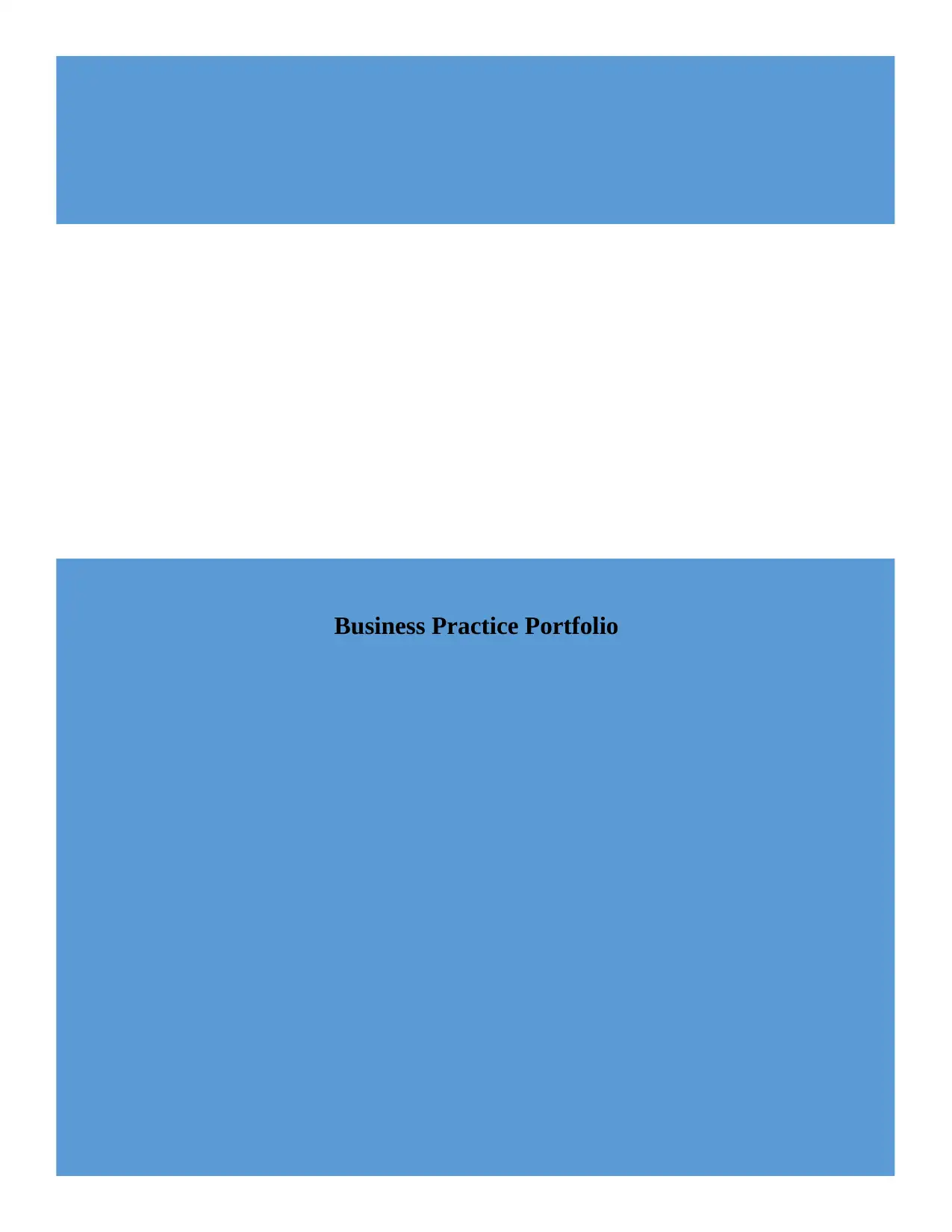
Business Practice Portfolio
Paraphrase This Document
Need a fresh take? Get an instant paraphrase of this document with our AI Paraphraser
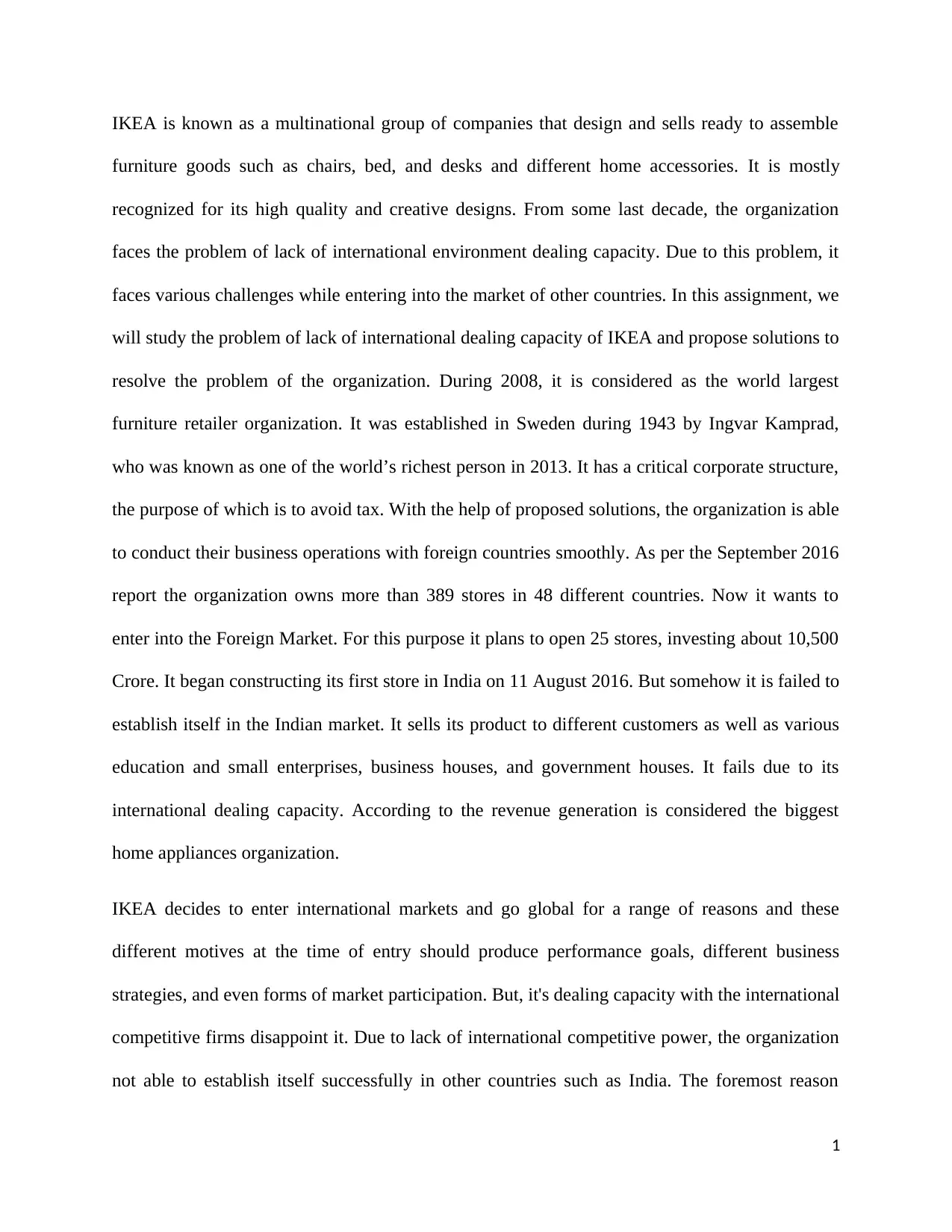
IKEA is known as a multinational group of companies that design and sells ready to assemble
furniture goods such as chairs, bed, and desks and different home accessories. It is mostly
recognized for its high quality and creative designs. From some last decade, the organization
faces the problem of lack of international environment dealing capacity. Due to this problem, it
faces various challenges while entering into the market of other countries. In this assignment, we
will study the problem of lack of international dealing capacity of IKEA and propose solutions to
resolve the problem of the organization. During 2008, it is considered as the world largest
furniture retailer organization. It was established in Sweden during 1943 by Ingvar Kamprad,
who was known as one of the world’s richest person in 2013. It has a critical corporate structure,
the purpose of which is to avoid tax. With the help of proposed solutions, the organization is able
to conduct their business operations with foreign countries smoothly. As per the September 2016
report the organization owns more than 389 stores in 48 different countries. Now it wants to
enter into the Foreign Market. For this purpose it plans to open 25 stores, investing about 10,500
Crore. It began constructing its first store in India on 11 August 2016. But somehow it is failed to
establish itself in the Indian market. It sells its product to different customers as well as various
education and small enterprises, business houses, and government houses. It fails due to its
international dealing capacity. According to the revenue generation is considered the biggest
home appliances organization.
IKEA decides to enter international markets and go global for a range of reasons and these
different motives at the time of entry should produce performance goals, different business
strategies, and even forms of market participation. But, it's dealing capacity with the international
competitive firms disappoint it. Due to lack of international competitive power, the organization
not able to establish itself successfully in other countries such as India. The foremost reason
1
furniture goods such as chairs, bed, and desks and different home accessories. It is mostly
recognized for its high quality and creative designs. From some last decade, the organization
faces the problem of lack of international environment dealing capacity. Due to this problem, it
faces various challenges while entering into the market of other countries. In this assignment, we
will study the problem of lack of international dealing capacity of IKEA and propose solutions to
resolve the problem of the organization. During 2008, it is considered as the world largest
furniture retailer organization. It was established in Sweden during 1943 by Ingvar Kamprad,
who was known as one of the world’s richest person in 2013. It has a critical corporate structure,
the purpose of which is to avoid tax. With the help of proposed solutions, the organization is able
to conduct their business operations with foreign countries smoothly. As per the September 2016
report the organization owns more than 389 stores in 48 different countries. Now it wants to
enter into the Foreign Market. For this purpose it plans to open 25 stores, investing about 10,500
Crore. It began constructing its first store in India on 11 August 2016. But somehow it is failed to
establish itself in the Indian market. It sells its product to different customers as well as various
education and small enterprises, business houses, and government houses. It fails due to its
international dealing capacity. According to the revenue generation is considered the biggest
home appliances organization.
IKEA decides to enter international markets and go global for a range of reasons and these
different motives at the time of entry should produce performance goals, different business
strategies, and even forms of market participation. But, it's dealing capacity with the international
competitive firms disappoint it. Due to lack of international competitive power, the organization
not able to establish itself successfully in other countries such as India. The foremost reason
1
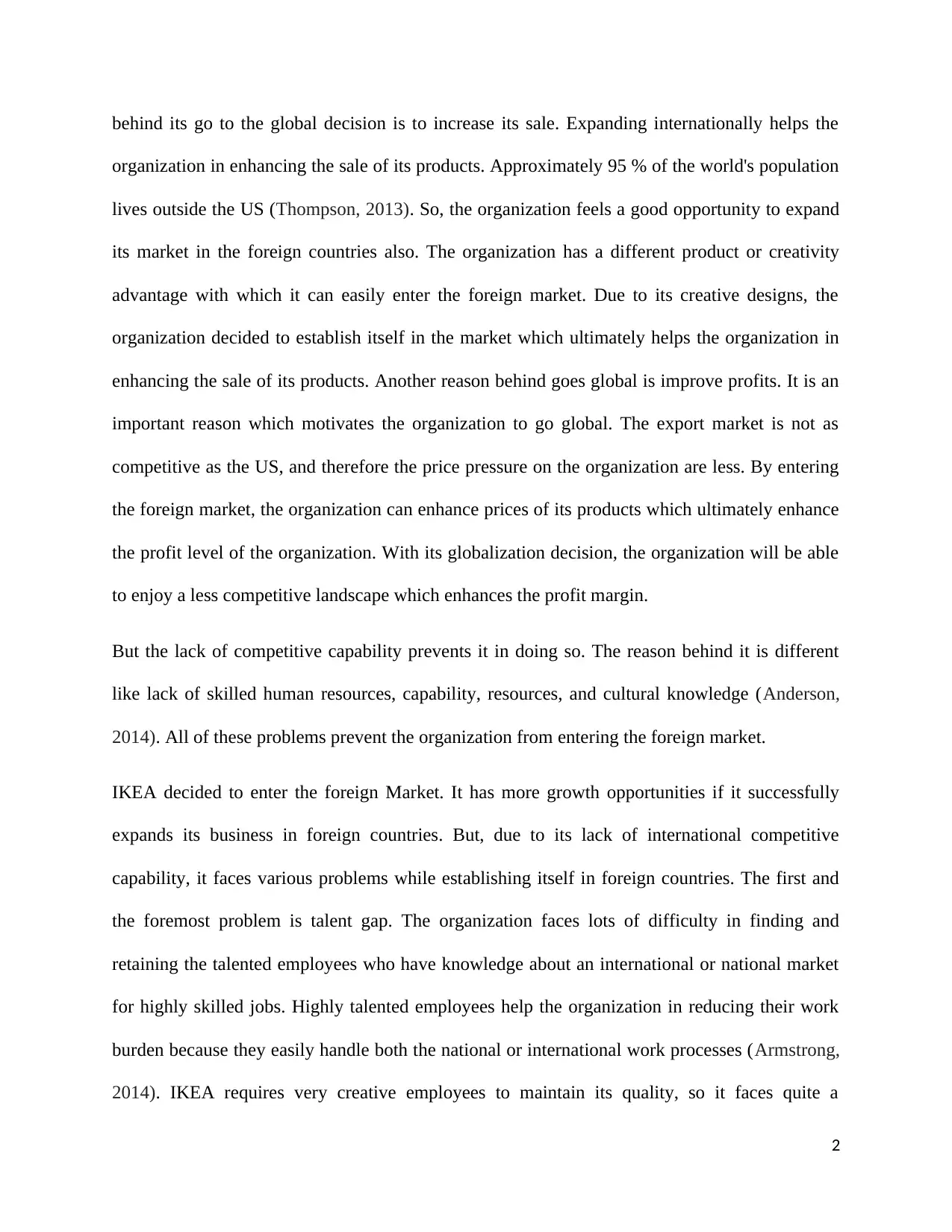
behind its go to the global decision is to increase its sale. Expanding internationally helps the
organization in enhancing the sale of its products. Approximately 95 % of the world's population
lives outside the US (Thompson, 2013). So, the organization feels a good opportunity to expand
its market in the foreign countries also. The organization has a different product or creativity
advantage with which it can easily enter the foreign market. Due to its creative designs, the
organization decided to establish itself in the market which ultimately helps the organization in
enhancing the sale of its products. Another reason behind goes global is improve profits. It is an
important reason which motivates the organization to go global. The export market is not as
competitive as the US, and therefore the price pressure on the organization are less. By entering
the foreign market, the organization can enhance prices of its products which ultimately enhance
the profit level of the organization. With its globalization decision, the organization will be able
to enjoy a less competitive landscape which enhances the profit margin.
But the lack of competitive capability prevents it in doing so. The reason behind it is different
like lack of skilled human resources, capability, resources, and cultural knowledge (Anderson,
2014). All of these problems prevent the organization from entering the foreign market.
IKEA decided to enter the foreign Market. It has more growth opportunities if it successfully
expands its business in foreign countries. But, due to its lack of international competitive
capability, it faces various problems while establishing itself in foreign countries. The first and
the foremost problem is talent gap. The organization faces lots of difficulty in finding and
retaining the talented employees who have knowledge about an international or national market
for highly skilled jobs. Highly talented employees help the organization in reducing their work
burden because they easily handle both the national or international work processes (Armstrong,
2014). IKEA requires very creative employees to maintain its quality, so it faces quite a
2
organization in enhancing the sale of its products. Approximately 95 % of the world's population
lives outside the US (Thompson, 2013). So, the organization feels a good opportunity to expand
its market in the foreign countries also. The organization has a different product or creativity
advantage with which it can easily enter the foreign market. Due to its creative designs, the
organization decided to establish itself in the market which ultimately helps the organization in
enhancing the sale of its products. Another reason behind goes global is improve profits. It is an
important reason which motivates the organization to go global. The export market is not as
competitive as the US, and therefore the price pressure on the organization are less. By entering
the foreign market, the organization can enhance prices of its products which ultimately enhance
the profit level of the organization. With its globalization decision, the organization will be able
to enjoy a less competitive landscape which enhances the profit margin.
But the lack of competitive capability prevents it in doing so. The reason behind it is different
like lack of skilled human resources, capability, resources, and cultural knowledge (Anderson,
2014). All of these problems prevent the organization from entering the foreign market.
IKEA decided to enter the foreign Market. It has more growth opportunities if it successfully
expands its business in foreign countries. But, due to its lack of international competitive
capability, it faces various problems while establishing itself in foreign countries. The first and
the foremost problem is talent gap. The organization faces lots of difficulty in finding and
retaining the talented employees who have knowledge about an international or national market
for highly skilled jobs. Highly talented employees help the organization in reducing their work
burden because they easily handle both the national or international work processes (Armstrong,
2014). IKEA requires very creative employees to maintain its quality, so it faces quite a
2
⊘ This is a preview!⊘
Do you want full access?
Subscribe today to unlock all pages.

Trusted by 1+ million students worldwide
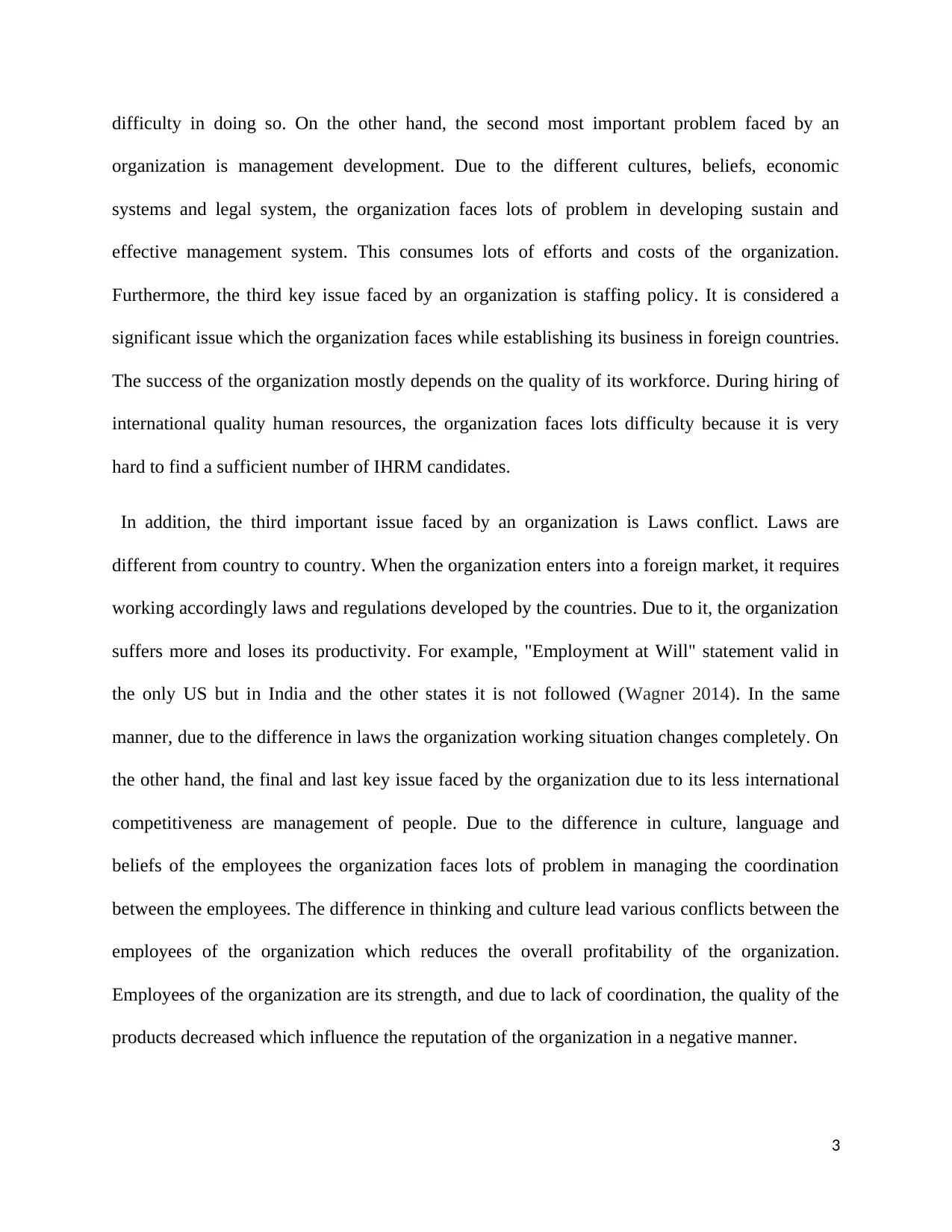
difficulty in doing so. On the other hand, the second most important problem faced by an
organization is management development. Due to the different cultures, beliefs, economic
systems and legal system, the organization faces lots of problem in developing sustain and
effective management system. This consumes lots of efforts and costs of the organization.
Furthermore, the third key issue faced by an organization is staffing policy. It is considered a
significant issue which the organization faces while establishing its business in foreign countries.
The success of the organization mostly depends on the quality of its workforce. During hiring of
international quality human resources, the organization faces lots difficulty because it is very
hard to find a sufficient number of IHRM candidates.
In addition, the third important issue faced by an organization is Laws conflict. Laws are
different from country to country. When the organization enters into a foreign market, it requires
working accordingly laws and regulations developed by the countries. Due to it, the organization
suffers more and loses its productivity. For example, "Employment at Will" statement valid in
the only US but in India and the other states it is not followed (Wagner 2014). In the same
manner, due to the difference in laws the organization working situation changes completely. On
the other hand, the final and last key issue faced by the organization due to its less international
competitiveness are management of people. Due to the difference in culture, language and
beliefs of the employees the organization faces lots of problem in managing the coordination
between the employees. The difference in thinking and culture lead various conflicts between the
employees of the organization which reduces the overall profitability of the organization.
Employees of the organization are its strength, and due to lack of coordination, the quality of the
products decreased which influence the reputation of the organization in a negative manner.
3
organization is management development. Due to the different cultures, beliefs, economic
systems and legal system, the organization faces lots of problem in developing sustain and
effective management system. This consumes lots of efforts and costs of the organization.
Furthermore, the third key issue faced by an organization is staffing policy. It is considered a
significant issue which the organization faces while establishing its business in foreign countries.
The success of the organization mostly depends on the quality of its workforce. During hiring of
international quality human resources, the organization faces lots difficulty because it is very
hard to find a sufficient number of IHRM candidates.
In addition, the third important issue faced by an organization is Laws conflict. Laws are
different from country to country. When the organization enters into a foreign market, it requires
working accordingly laws and regulations developed by the countries. Due to it, the organization
suffers more and loses its productivity. For example, "Employment at Will" statement valid in
the only US but in India and the other states it is not followed (Wagner 2014). In the same
manner, due to the difference in laws the organization working situation changes completely. On
the other hand, the final and last key issue faced by the organization due to its less international
competitiveness are management of people. Due to the difference in culture, language and
beliefs of the employees the organization faces lots of problem in managing the coordination
between the employees. The difference in thinking and culture lead various conflicts between the
employees of the organization which reduces the overall profitability of the organization.
Employees of the organization are its strength, and due to lack of coordination, the quality of the
products decreased which influence the reputation of the organization in a negative manner.
3
Paraphrase This Document
Need a fresh take? Get an instant paraphrase of this document with our AI Paraphraser
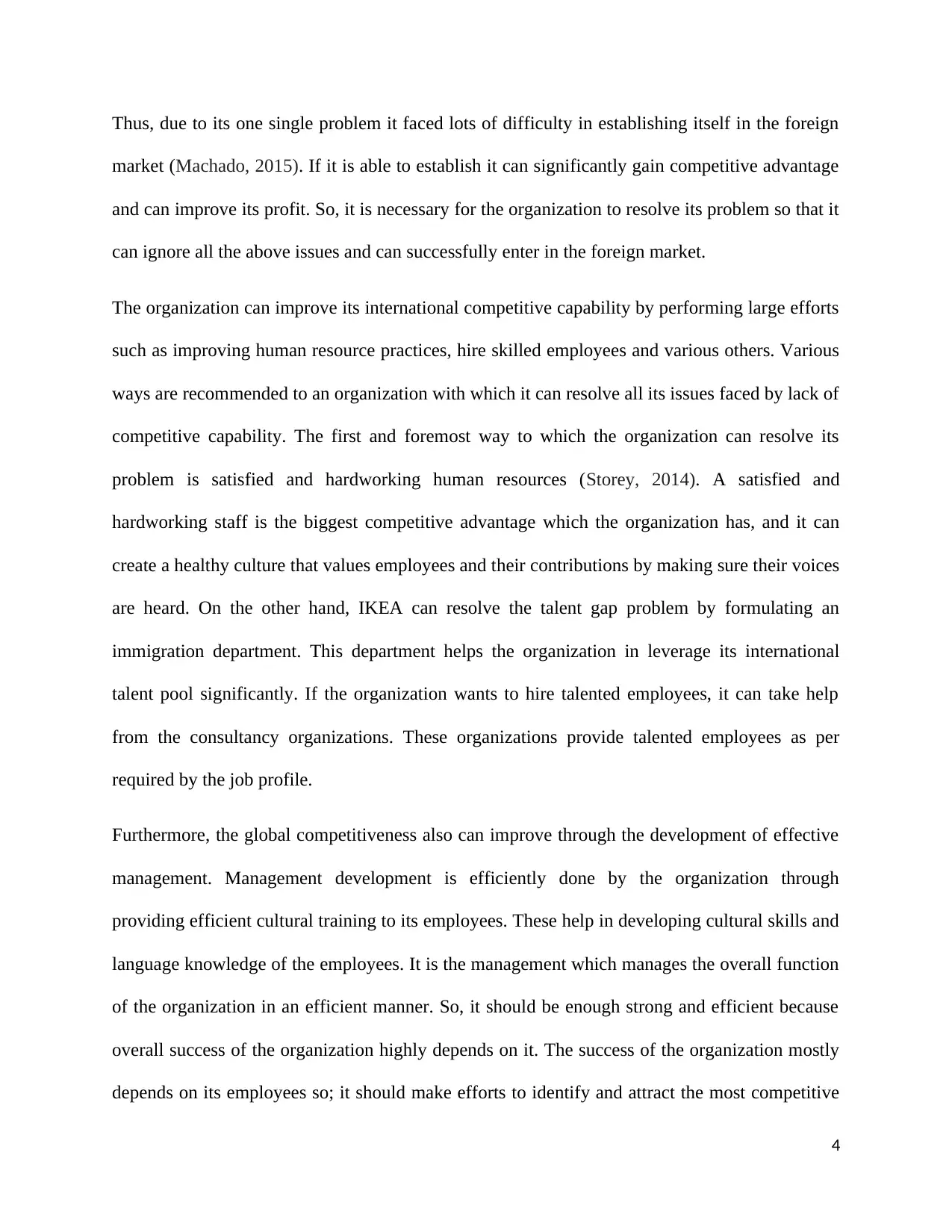
Thus, due to its one single problem it faced lots of difficulty in establishing itself in the foreign
market (Machado, 2015). If it is able to establish it can significantly gain competitive advantage
and can improve its profit. So, it is necessary for the organization to resolve its problem so that it
can ignore all the above issues and can successfully enter in the foreign market.
The organization can improve its international competitive capability by performing large efforts
such as improving human resource practices, hire skilled employees and various others. Various
ways are recommended to an organization with which it can resolve all its issues faced by lack of
competitive capability. The first and foremost way to which the organization can resolve its
problem is satisfied and hardworking human resources (Storey, 2014). A satisfied and
hardworking staff is the biggest competitive advantage which the organization has, and it can
create a healthy culture that values employees and their contributions by making sure their voices
are heard. On the other hand, IKEA can resolve the talent gap problem by formulating an
immigration department. This department helps the organization in leverage its international
talent pool significantly. If the organization wants to hire talented employees, it can take help
from the consultancy organizations. These organizations provide talented employees as per
required by the job profile.
Furthermore, the global competitiveness also can improve through the development of effective
management. Management development is efficiently done by the organization through
providing efficient cultural training to its employees. These help in developing cultural skills and
language knowledge of the employees. It is the management which manages the overall function
of the organization in an efficient manner. So, it should be enough strong and efficient because
overall success of the organization highly depends on it. The success of the organization mostly
depends on its employees so; it should make efforts to identify and attract the most competitive
4
market (Machado, 2015). If it is able to establish it can significantly gain competitive advantage
and can improve its profit. So, it is necessary for the organization to resolve its problem so that it
can ignore all the above issues and can successfully enter in the foreign market.
The organization can improve its international competitive capability by performing large efforts
such as improving human resource practices, hire skilled employees and various others. Various
ways are recommended to an organization with which it can resolve all its issues faced by lack of
competitive capability. The first and foremost way to which the organization can resolve its
problem is satisfied and hardworking human resources (Storey, 2014). A satisfied and
hardworking staff is the biggest competitive advantage which the organization has, and it can
create a healthy culture that values employees and their contributions by making sure their voices
are heard. On the other hand, IKEA can resolve the talent gap problem by formulating an
immigration department. This department helps the organization in leverage its international
talent pool significantly. If the organization wants to hire talented employees, it can take help
from the consultancy organizations. These organizations provide talented employees as per
required by the job profile.
Furthermore, the global competitiveness also can improve through the development of effective
management. Management development is efficiently done by the organization through
providing efficient cultural training to its employees. These help in developing cultural skills and
language knowledge of the employees. It is the management which manages the overall function
of the organization in an efficient manner. So, it should be enough strong and efficient because
overall success of the organization highly depends on it. The success of the organization mostly
depends on its employees so; it should make efforts to identify and attract the most competitive
4
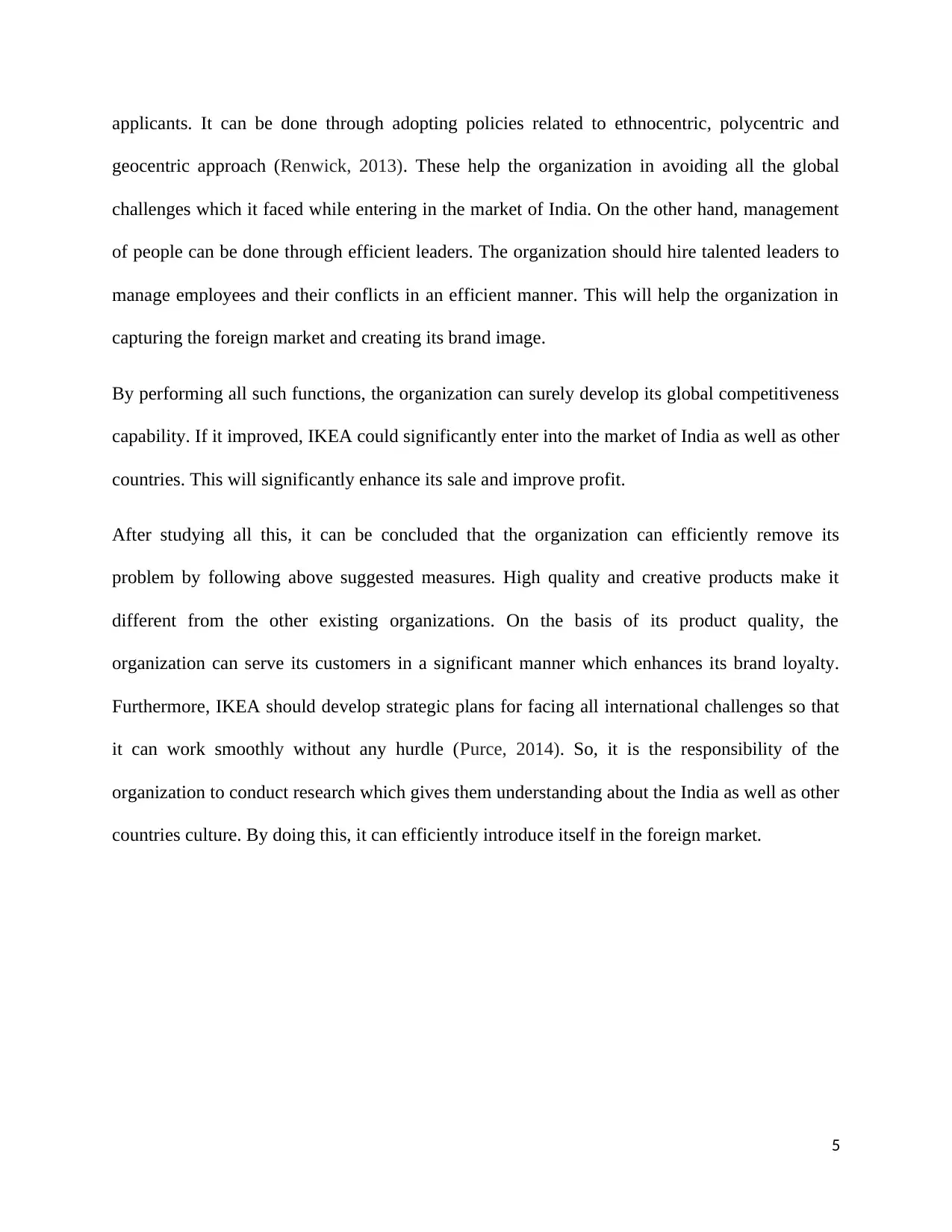
applicants. It can be done through adopting policies related to ethnocentric, polycentric and
geocentric approach (Renwick, 2013). These help the organization in avoiding all the global
challenges which it faced while entering in the market of India. On the other hand, management
of people can be done through efficient leaders. The organization should hire talented leaders to
manage employees and their conflicts in an efficient manner. This will help the organization in
capturing the foreign market and creating its brand image.
By performing all such functions, the organization can surely develop its global competitiveness
capability. If it improved, IKEA could significantly enter into the market of India as well as other
countries. This will significantly enhance its sale and improve profit.
After studying all this, it can be concluded that the organization can efficiently remove its
problem by following above suggested measures. High quality and creative products make it
different from the other existing organizations. On the basis of its product quality, the
organization can serve its customers in a significant manner which enhances its brand loyalty.
Furthermore, IKEA should develop strategic plans for facing all international challenges so that
it can work smoothly without any hurdle (Purce, 2014). So, it is the responsibility of the
organization to conduct research which gives them understanding about the India as well as other
countries culture. By doing this, it can efficiently introduce itself in the foreign market.
5
geocentric approach (Renwick, 2013). These help the organization in avoiding all the global
challenges which it faced while entering in the market of India. On the other hand, management
of people can be done through efficient leaders. The organization should hire talented leaders to
manage employees and their conflicts in an efficient manner. This will help the organization in
capturing the foreign market and creating its brand image.
By performing all such functions, the organization can surely develop its global competitiveness
capability. If it improved, IKEA could significantly enter into the market of India as well as other
countries. This will significantly enhance its sale and improve profit.
After studying all this, it can be concluded that the organization can efficiently remove its
problem by following above suggested measures. High quality and creative products make it
different from the other existing organizations. On the basis of its product quality, the
organization can serve its customers in a significant manner which enhances its brand loyalty.
Furthermore, IKEA should develop strategic plans for facing all international challenges so that
it can work smoothly without any hurdle (Purce, 2014). So, it is the responsibility of the
organization to conduct research which gives them understanding about the India as well as other
countries culture. By doing this, it can efficiently introduce itself in the foreign market.
5
⊘ This is a preview!⊘
Do you want full access?
Subscribe today to unlock all pages.

Trusted by 1+ million students worldwide
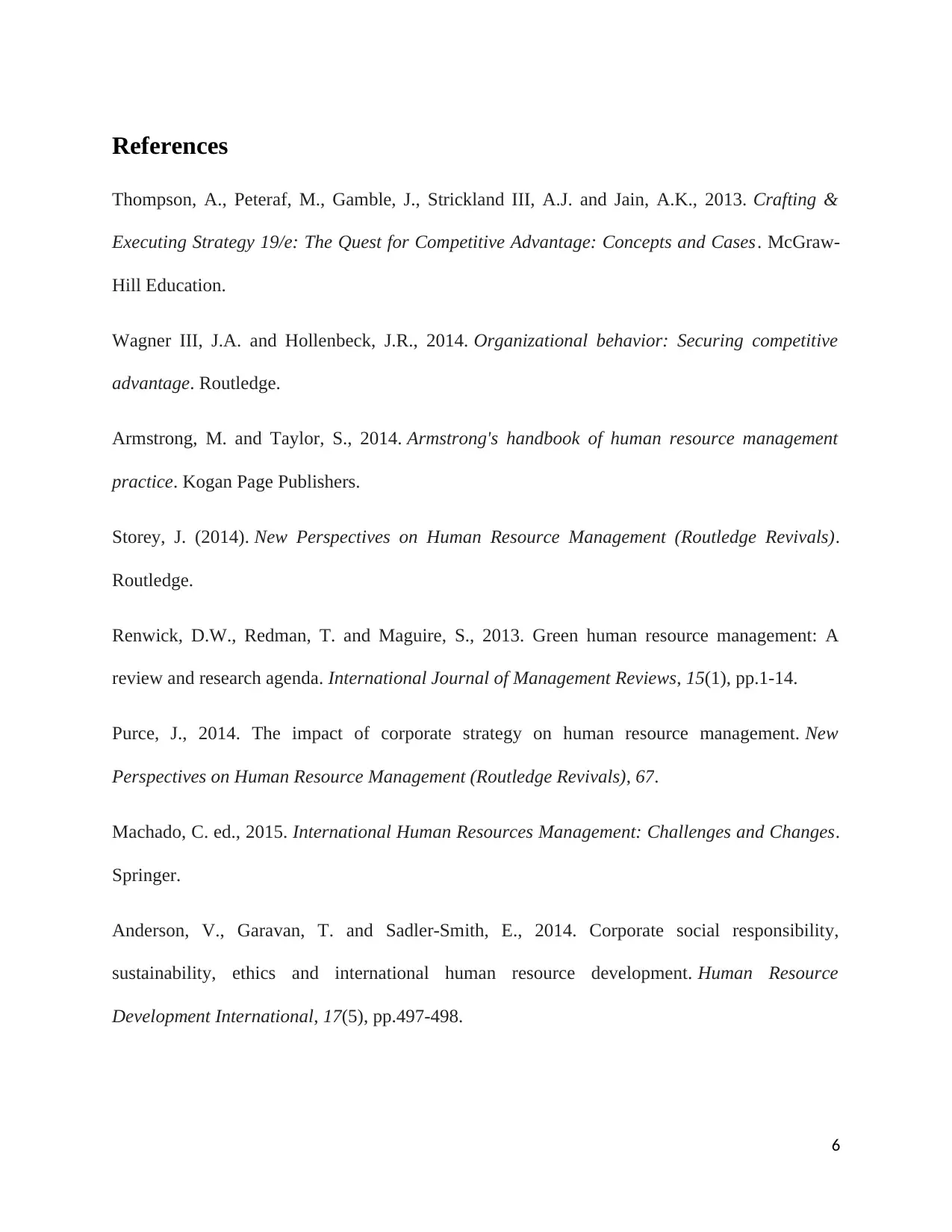
References
Thompson, A., Peteraf, M., Gamble, J., Strickland III, A.J. and Jain, A.K., 2013. Crafting &
Executing Strategy 19/e: The Quest for Competitive Advantage: Concepts and Cases. McGraw-
Hill Education.
Wagner III, J.A. and Hollenbeck, J.R., 2014. Organizational behavior: Securing competitive
advantage. Routledge.
Armstrong, M. and Taylor, S., 2014. Armstrong's handbook of human resource management
practice. Kogan Page Publishers.
Storey, J. (2014). New Perspectives on Human Resource Management (Routledge Revivals).
Routledge.
Renwick, D.W., Redman, T. and Maguire, S., 2013. Green human resource management: A
review and research agenda. International Journal of Management Reviews, 15(1), pp.1-14.
Purce, J., 2014. The impact of corporate strategy on human resource management. New
Perspectives on Human Resource Management (Routledge Revivals), 67.
Machado, C. ed., 2015. International Human Resources Management: Challenges and Changes.
Springer.
Anderson, V., Garavan, T. and Sadler-Smith, E., 2014. Corporate social responsibility,
sustainability, ethics and international human resource development. Human Resource
Development International, 17(5), pp.497-498.
6
Thompson, A., Peteraf, M., Gamble, J., Strickland III, A.J. and Jain, A.K., 2013. Crafting &
Executing Strategy 19/e: The Quest for Competitive Advantage: Concepts and Cases. McGraw-
Hill Education.
Wagner III, J.A. and Hollenbeck, J.R., 2014. Organizational behavior: Securing competitive
advantage. Routledge.
Armstrong, M. and Taylor, S., 2014. Armstrong's handbook of human resource management
practice. Kogan Page Publishers.
Storey, J. (2014). New Perspectives on Human Resource Management (Routledge Revivals).
Routledge.
Renwick, D.W., Redman, T. and Maguire, S., 2013. Green human resource management: A
review and research agenda. International Journal of Management Reviews, 15(1), pp.1-14.
Purce, J., 2014. The impact of corporate strategy on human resource management. New
Perspectives on Human Resource Management (Routledge Revivals), 67.
Machado, C. ed., 2015. International Human Resources Management: Challenges and Changes.
Springer.
Anderson, V., Garavan, T. and Sadler-Smith, E., 2014. Corporate social responsibility,
sustainability, ethics and international human resource development. Human Resource
Development International, 17(5), pp.497-498.
6
Paraphrase This Document
Need a fresh take? Get an instant paraphrase of this document with our AI Paraphraser

7
1 out of 8
Related Documents
Your All-in-One AI-Powered Toolkit for Academic Success.
+13062052269
info@desklib.com
Available 24*7 on WhatsApp / Email
![[object Object]](/_next/static/media/star-bottom.7253800d.svg)
Unlock your academic potential
Copyright © 2020–2025 A2Z Services. All Rights Reserved. Developed and managed by ZUCOL.




